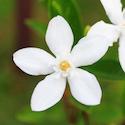Updated September 6th, 2023
Are you eagerly waiting for those lovely, waxy jasmine flowers, having meticulously cared for your plant, only to find out that your jasmine isn't blooming? It can be quite baffling.
The plant seems healthy, with lush green foliage, but those precious flower buds just won't make an appearance. Then, why is my Jasmine not flowering?
Jasmine plants may not flower due to factors like water stress, insufficient sunlight, drought stress, poor soil nutrients, improper fertilisation, and suboptimal feeding, composting, and pruning methods.
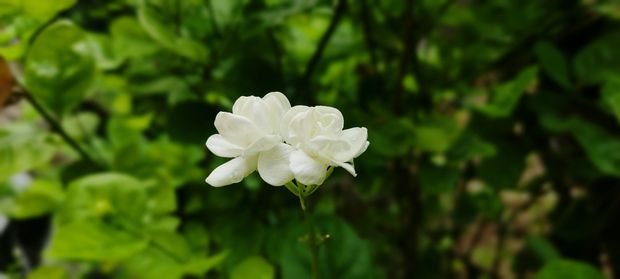
No need to worry, though, as mentioned above, there are several reasons why your jasmine might not be flowering, and understanding these factors will help you resolve the issue and elevate your jasmine plant care.
Of course, there are various types of jasmine, each with its own specific care requirements to optimise growth and flowering. They also bloom at different times of the year and thrive under different environmental conditions. These are the most common and popular jasmine species and varieties and their blooming times:
- Common Jasmine (Jasminum officinale): This variety is more sensitive to cold and typically blooms in early spring, with the potential for re-blooming in summer.
- Winter Jasmine (Jasminum nudiflorum): Known for its hardiness, Winter Jasmine flowers from November to March, adding a burst of colour to the winter garden.
- Pink Jasmine or Many-Flowered Jasmine (Jasminum polyanthum): Often grown as a houseplant due to its sensitivity to cold, it typically graces us with its fragrant blossoms in April to June.
- Arabian Jasmine (Jasminum sambac): A popular choice for its sweet fragrance, it tends to bloom throughout the year, with peak flowering in the warmer months.
- Confederate Jasmine (Trachelospermum jasminoides): This evergreen climber offers fragrant white blossoms in late spring to early summer.
- Italian Jasmine (Jasminum humile): With bright yellow blooms, it typically flowers from late spring to early summer.
To establish when your Jasmine should bloom and its hardiness in your climate, refer to the plant label. Keep in mind that various factors can influence flowering timing, so your plant may bloom slightly earlier or later than the typical season for its species.
Nevertheless, they all follow some general guidelines to ensure they put on a vibrant show.
Why are there no flowers on our jasmine plant? All the reasons why your jasmine is to flowering
Insufficient Sunlight
Jasmine plants, much like many other flowering species, flourish when they are bathed in abundant sunlight. If your Jasmine isn't soaking in a minimum of 5-6 hours of direct sunlight each day, it might find itself lacking the necessary vitality to produce those beautiful flowers we all adore.
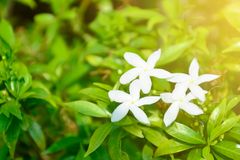
Across all Jasmine species, the extent of their bloom and the intensity of their fragrant allure are intrinsically tied to the hours of sunshine they receive.
Jasmine's origin traces back to the tropical and subtropical regions of Asia, where it naturally revels in the warmth and brilliance of full sunlight.
While some Jasmine varieties can adapt to various climates (as seen with Winter Jasmine), they all converge on one fundamental requirement - an ample dose of sunlight to stage their splendid floral showcases.
During the spring and summer seasons, Jasmine can start its blooming journey with just six hours of direct sunlight per day, yet it truly thrives when basking in even more sunshine.
In fact, the greater the sun's embrace, the heartier the plant becomes, and the more exuberant the display of blossoms it offers.
Should your Jasmine be privy to less than six hours of direct sunlight, it might find itself in a struggle, lacking the vigour required for a profusion of flowers.
In such instances, consider relocating it to a sunnier haven, particularly facing south if it's an outdoor inhabitant. Consider using my recommended and effective Outdoors Sunlight Lamps
For indoor Jasmine, ensure it graces the sunniest window, inviting in the radiant rays that coax forth its splendid floral exhibition. I recommend you grab one of these Window Sunlight Lamps as they are cheap and efficient in providing additional light.
Improper Fertilisation
Fertilising your Jasmine with the wrong type or balance of nutrients can hinder flowering. These plants benefit from a balanced fertiliser with a formulation like 30-35% Nitrogen, 45-50% Phosphorus, and 20% Potassium (NPK 20-20-20) to promote flowering.
My honest recommendation here is to use Miracle- Gro tons of flowers to indeed obtain loads of beautiful blooms!
Using a fertiliser with different proportions may lead to excessive foliage growth at the expense of flowers. Keep reading below for more crucial information about fertilising your Jasmine to get tons of flowers!
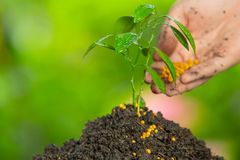
Lack of Nutrients
Jasmine plants require essential nutrients for healthy growth and flowering. Poor soil quality or nutrient deficiencies can limit flower bud development. Ensure your plant is in well-draining, nutrient-rich soil to provide the necessary foundation for robust flower production.
I always use Optimum Jasmine soil to ensure it drains well and my jasmines are well moist.
Inadequate Watering
Inconsistent or insufficient watering can stress your Jasmine plant, affecting its ability to produce flowers. This is called drought stress.
Jasmine thrives when its roots are nestled in soil that strikes the perfect balance – consistently moist yet well-draining, ensuring excess water doesn't linger around the roots.
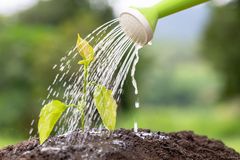
When the soil surrounding your Jasmine's roots dries out completely, it triggers stress that can hinder the plant's ability to produce those delightful blossoms, especially when drought strikes during the crucial bud development phase in spring.
Under-watered Jasmine can display telltale signs: leaves that droop or curl, stunt growth, and a dearth of flowers. However, it's important to note that a shortage of moisture isn't always the sole culprit behind drought stress. There could be multiple factors at play, contributing to Jasmine's reluctance to bloom.
In contrast, it is well-known that drought stress can impede flowering, the opposite holds true as well – excessive moisture around the roots can have the same effect. Jasmine thrives in soil that maintains a delicate balance between moisture and drainage, and it simply doesn't tolerate soggy conditions enveloping its roots.
Aggressive watering can pose a challenge to Jasmine's blooming potential, especially when the soil lacks proper drainage and structure. Frequent watering combined with slow-draining soil can lead to water stress, hindering Jasmine's ability to burst into full bloom.
Overly saturated soil can manifest in a Jasmine plant adorned with wilted, yellowing leaves and a diminished display of blossoms. This excess water not only predisposes the plant to fungal diseases but also robs the roots of vital oxygen, further hampering the flowering process.
Incorrect Pot Size
If your Jasmine is in a pot, the container size matters. An overcrowded or undersized pot can restrict root growth, which is essential for flowering.
My favourite pots and beds, the ones I never have trouble with are these Jasmine indoor pots
If you are thinking of the outdoors jasmines or other plants, my go-tos are these Jasmine optimum beds
Transplant your Jasmine to a larger pot if it has outgrown its current one to allow for healthy root development.
Environmental Stress
Extreme environmental conditions like very high or low temperatures, drought, winds or excessive humidity can stress your Jasmine and inhibit flowering. Providing a stable and comfortable environment for your plant is crucial for optimal flower production. Some examples of environmental stress are:
- Unrelenting Winds: Jasmine, the graceful climber, finds its natural habitat in sheltered nooks, often leaning against walls or fences where it welcomes gentle breezes. This can be a pretty big problem in order to get beautiful and stable blooms, if there are too high winds, our jasmines will get damage and it will go into "protection mode", this will ultimately result in no flowers. Try these Jasmine Wind Shields
- Sandy Soil: Jasmine has a particular fondness for soil that boasts ample moisture and organic richness—compost, leaf mould, well-rotted manure, and the like. Yet, if your soil leans towards the sandy side of the spectrum, it tends to drain too swiftly for Jasmine's roots to access the moisture they crave, leading to drought conditions and a subsequent dearth of blossoms.
- Thirsty Pots and Containers: While Jasmine thrives in pots, this comes with an added responsibility—vigilant watering. Jasmine craves the warmth of full sun, which can hasten the drying process, especially in smaller pots. Neglecting watering duties can result in drought stress, diminishing the floral display potential.
- The Curse of Slow-Draining Soils: When the native soil is inherently boggy or sluggishly draining due to heavy clay content, Jasmine faces an elevated risk of root rot. This menacing condition not only hampers flowering but also threatens the overall health of the plant, often leading to dieback.
- Properly Potted: Ensuring that pots and containers have well-placed drainage holes at their base is paramount. Adequate drainage prevents water from stagnating around the roots, thwarting the chances of flowering and, in extreme cases, causing the plant's demise. Blockages from compacted soil or encroaching roots should be diligently prevented to maintain optimal drainage.
Pest and Disease Issues
Pest infestations or diseases can weaken your Jasmine plant, diverting its energy away from flowering. Regularly inspect your plant for signs of pests or diseases and take appropriate measures for control and prevention.
Plant Age
Younger Jasmine plants may take some time to establish themselves before they start producing flowers. Be patient, and with proper care, they will likely start blooming as they mature.
Wrong Jasmine Variety
Different Jasmine species have varying flowering times and levels of profusion. Some may naturally produce fewer flowers or bloom at specific times of the year. It's essential to identify your specific Jasmine variety to understand its flowering habits accurately.
Improper Pruning Techniques
Using incorrect pruning techniques can have unintended consequences. Honestly, I can’t emphasise enough how crucial it is to optimise your pruning techniques to keep your Jasmine blooming if at all! Please read below to gather the details.
Not least importantly it is to prune with the right tools otherwise you might end up damaging the cells of the plant.
Using dirty and not very sharp tools can have awful consequences for the flowering of our Jasmine.
If you prune too aggressively or cut the wrong branches, you may remove potential flowering stems. It's essential to learn the proper pruning methods for your specific Jasmine variety to encourage optimal flowering.
Inadequate Cooling Period
Jasmine plants require a cooling period for optimal flower production. After the warm months, place your potted jasmine outdoors during autumn when temperatures range between 10-15 degrees Celsius. This cooling and resting period is crucial for stimulating flower bud development. Before winter's first frost, bring your jasmine plant back indoors. This is actually particularly true for some Jasmine varieties, like Arabian Jasmine.
During winter, you'll notice small flower buds forming. Once they begin to bloom, move the plant indoors, preferably to a cooler room or porch with indirect sunlight to prolong the blooming period. Regularly inspect the plant for root-bound issues. If necessary, trim the roots, refresh the compost, and provide a trellis to support its climbing growth for the following year.
Root-Bound Plants
Jasmine plants with root-bound root systems may struggle to access the nutrients needed for flowering. If the roots have taken up most of the pot space, it's time to consider repotting.
Loosen the roots and provide fresh soil to encourage better nutrient absorption. Make sure to use gardening gloves so as not to disrupt the roots and transmit diseases or infections to the plants.
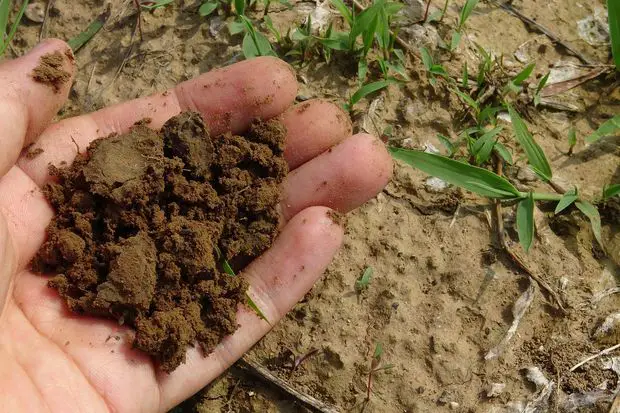
Pollination Issues
For some Jasmine varieties, especially those grown indoors, the absence of pollinators like bees can impact flower production. You may need to manually pollinate the flowers by gently transferring pollen from one bloom to another using a small brush or cotton swab.
Stress from Transplanting
Transplanting your Jasmine without proper care can stress the plant and delay or reduce flowering. If you recently transplanted your Jasmine, ensure it receives adequate care and attention to recover and resume its flowering cycle.
How do I get my jasmine plant to flower more? How to increase flowering in jasmine plant
Your Jasmine plant may look healthy with lush, vibrant green foliage, but it's not producing flowers, or perhaps you had blooms in the first year but not since. Regardless of your situation, I'll guide you through two key factors to enhance Jasmine's blooming.
Optimise Pruning and cutting off
After the initial spring bloom of your Jasmine plant, it's crucial to prune away the old, dry blossoms. To encourage abundant blossoming, maintain a cooler environment.
Since Jasmine is a climbing vine that tends to sprawl, regular pruning is essential. Each cut will result in two new shoots, creating a denser plant with more flower buds. Continue pruning throughout the summer to support vigorous growth and abundant flowering.
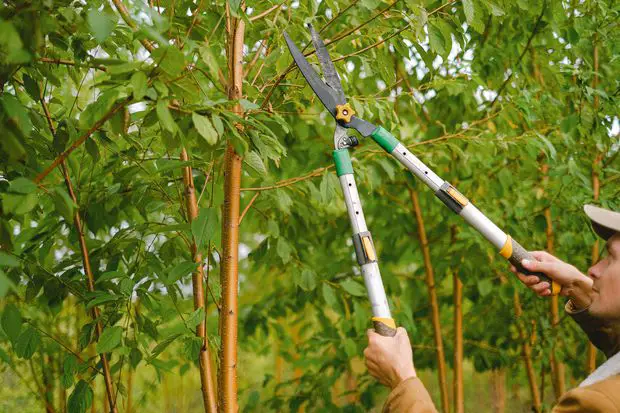
While pruning is essential for maintaining a healthy plant, excessive pruning can remove too many branches, leaves and new flower buds, reducing the plant's energy reserves. Without sufficient foliage, the Jasmine may not have the resources needed to produce flowers. And you know the sad part? It can postpone flowering for several years! My advice? Prune lightly always to strike a balance between maintenance and blooming potential!
Pruning your Jasmine at the wrong time can also disrupt the flowering process. Jasmine often blooms on new growth, so if you prune it too late in the season or right before the flowering period, you may inadvertently remove potential flower buds.
It's best to prune immediately after the blooming season to allow new shoots to develop for the next flowering cycle. Once flowering is complete, ensure frost isn't a risk and temperatures are rising before moving your Jasmine outdoors for the summer and autumn.
Follow a consistent watering schedule and feed it with half-strength fertiliser monthly. Pruning decisions can significantly impact the timing of your Jasmine's flowering, so it's crucial to strike the right balance for the results you desire.
Compost
To optimise your Jasmine's flowering potential, create a new compost mix by combining 15% garden soil, 15% sand, 15% cocopeat, 5% rice husk, and 50% organic manure.
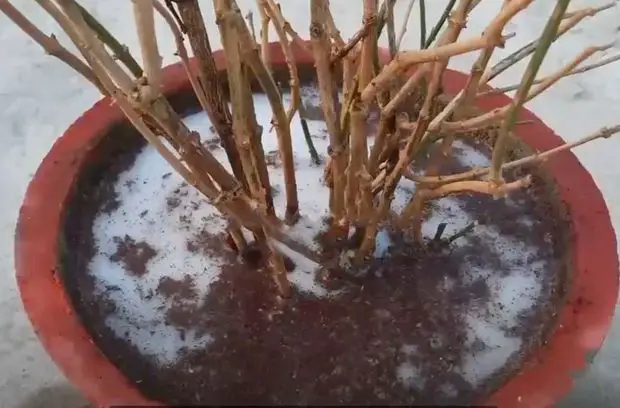
Thoroughly blend the mixture, repot your jasmine plant, and water it generously to reach the top of the pot. Place the plant in full sunlight for an entire day. After approximately 26 days, you'll observe lush green foliage.
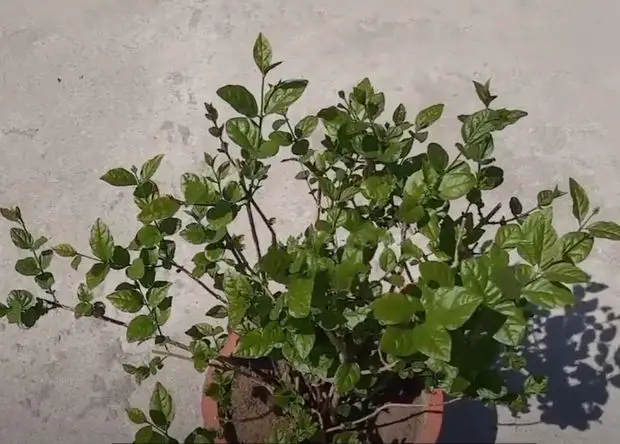
At this stage, try a trick I've learned over the years—add a bit more manure to the soil to stimulate robust growth. This sets the stage for more abundant blossoms later in the year.
Next, mix a teaspoon of urea in one litre of water in a spray bottle and apply it to the entire plant. By day 36, you'll notice numerous small to medium flower buds emerging from the stems.
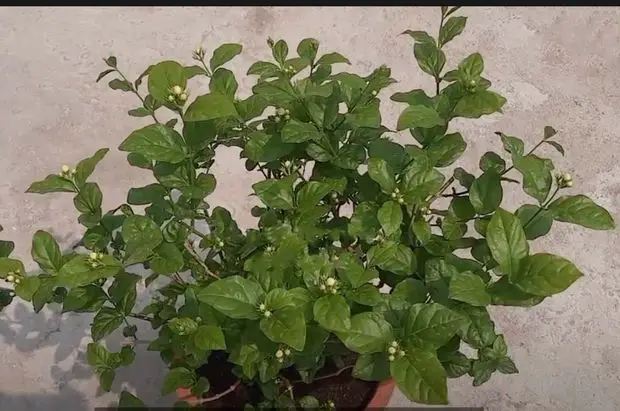
On day 42, mix a teaspoon of urea and a teaspoon of magnesium in a litre of water and spray it around the plant. By this time, your Jasmine will be in full bloom! To ensure ongoing health and growth, dissolve 3g of complete plant food (NPK 20-20-20) and a teaspoon of Trichoderma fungicide powder in a litre of water, then add this mixture to the potting soil.
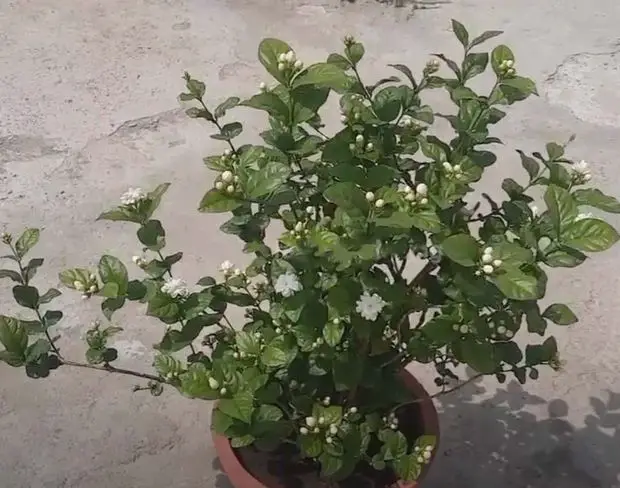
By day 44, your Jasmine plant will be adorned with beautiful flowers. To maintain the plant's health, ensure it's in well-draining, moderately soft soil, receives 5-6 hours of direct sunlight, and water it to a depth of 2 inches when the soil is semi-dry. Jasmine thrives in moderately moist to well-drained soil.
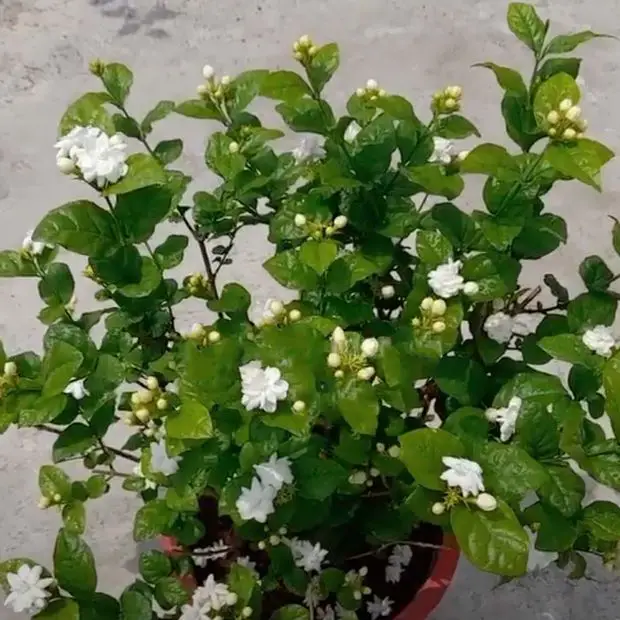
Optimised soil
When it comes to growing healthy and blooming Jasmine, the type of soil matters. If your soil is sandy and lacking nutrients, you'll likely notice Jasmine leaves turning yellow and fewer flowers.
Jasmine is often grown against walls, but these walls can limit root growth, making nutrient-rich soil crucial for good flowering. Ideally, enrich your soil with compost, leaf mould, and well-rotted manure to improve soil structure, moisture retention, and nutrient content.
For established Jasmine, mulch can be a game-changer. Apply a 1-inch layer of compost, leaf mould, or well-rotted manure on the soil's surface to boost nutrient availability around the roots.
Fertilisation is important too. Use a slow-release, all-purpose fertiliser twice a year (in spring and summer) to provide the necessary nutrients without overloading with nitrogen, which can hinder flowering.
In pots, Jasmine might run out of nutrients over time. If it's been in the same pot for a while, consider repotting it into a larger container with fresh soil. A bigger pot means more soil and better nutrient access for the roots.
For potted Jasmine, use high-quality multipurpose compost mixed with leaf mould and manure for a nutrient-rich soil blend. Remember, potted Jasmine often needs more attention. During spring to mid-summer, apply a well-balanced liquid fertiliser at half strength once a month. This routine supports not just blooms but overall plant health, ensuring your Jasmine flourishes beautifully.
Fertilisers. Use the best organic ones
Using the right fertiliser mix is crucial for achieving abundant Jasmine flowers. Jasmine thrives in nutrient-rich soil and can benefit from some fertiliser, but overdoing it can stifle flower production. My recommended one and I promise you will get big white blooms is Super Jasmine bloom
Excessive or frequent fertilisers, especially high-nitrogen formulas, may promote leaf growth at the expense of blooms. If your Jasmine boasts healthy green foliage but lacks flowers, you might be overfeeding it.
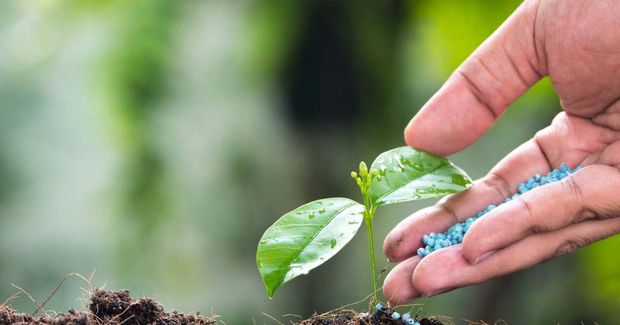
To remedy this, reduce fertiliser use and ensure consistent watering to dilute excess nutrients. While an over-fertilised Jasmine might not bloom this season, it should recover and flower in the following year.
To avoid such issues, consider slow-release granular fertilisers, like Miracle-Gro, which release nutrients gradually and in the right proportions, preventing a nitrogen overload.
These balanced fertilisers provide Jasmine with what it needs to flourish and flower appropriately. They are usually made of an optimised balanced formula of 30-35% Nitrogen, 45-50% Phosphorus, and 20% Potassium is essential for optimal results.
Let me share a personal experiment with my Jasmine plants as an example. Last year, I had two Arabian Jasmine plants. One was treated with cow manure and leaf compost, but it produced minimal to no flowers.
In contrast, the other plants received phosphorus and potassium-rich fertilisers like bone meal and triple-rich superphosphate every two months. The result? Abundant flowers and no empty stems.
The ideal proportions are crucial: 30% Nitrogen to control foliage growth, 50% Phosphorus to enhance flower bud formation, and Potassium to strengthen the roots and support stem growth for flowers.
For a homemade fertiliser, mix two tablespoons of banana peel (rich in potassium and phosphorus), one teaspoon of potash red powder, one teaspoon of urea, one teaspoon of triple superphosphate, one teaspoon of mustard powder mix (containing micronutrients), and half a teaspoon of fungicide powder. This mix is suitable for a 15-inch pot.
Apply it every two to three months, water your plant regularly, provide sufficient sunlight exposure, and watch your Jasmine bloom with beautiful flowers!
Fix drought stress
Achieving the right moisture balance is vital for your Jasmine's blossoming success. For mature Jasmines with well-established roots, occasional watering during drought is sufficient.
However, younger or potted Jasmines demand more attention, especially in spring and summer. Enhance root growth and resilience by providing a deep weekly soak. To help your Jasmine thrive, consider its environmental conditions. Shelter your plant from strong winds to prevent excessive moisture loss through its leaves.
Don't forget about mulch! Bark mulch can be a game-changer particularly, white pine bark.
Mulch with compost, leaf mould, or well-rotted manure in spring and fall to enrich the soil, conserve moisture, and protect the roots from frost. For potted Jasmines facing drought stress, consider upsizing to a larger pot with a water-retentive mix of multipurpose compost, leaf mould, and manure.
Indoor potted Jasmines should bask in the sunlight while staying clear of heat sources and drafts. With these measures, your Jasmine can recover from drought stress and potentially produce beautiful blooms in due time.
Fix overwatering stress
If you suspect your Jasmine is suffering from overwater stress, immediate action is essential. To help your Jasmine recover, first, adjust your watering routine by scaling back if overwatering is suspected.
For potted or container-bound Jasmines without proper drainage holes, consider repotting them into containers that facilitate excess water drainage.
For Jasmines planted in waterlogged garden soil, relocation is often the best solution. Transplant them to a garden area with well-prepared soil enriched with ample compost to improve soil structure and prevent root rot.
In situations where relocating your Jasmine is less practical, such as when it's anchored to a wall or fence, you can still rescue it by lifting the root ball and transferring it to a pot.
Amending potting soil is simpler than trying to modify naturally waterlogged ground. As you help your Jasmine recover and thrive, ensure the top two inches of soil dry out before each watering, offering your plant a chance to rebound and potentially grace your garden with beautiful blossoms once again.
Final thoughts
When it comes to coaxing your Jasmine to bloom, understanding a few key factors can make all the difference. Drought stress, excess nitrogen in the soil, and improper pruning are common culprits behind a non-blooming Jasmine. Pruning should be approached with care, mindful of the growth essential for flower development and timed correctly.
Different Jasmine species have their unique flowering seasons, so consult the plant label for guidance on when your variety should shine. Maintaining consistent moisture in the soil during the Spring and Summer is vital, striking the right balance between hydration and avoiding waterlogged conditions.
Lastly, while fertilisation is essential, excessive use can stimulate leaf growth at the expense of flowers. Plant your Jasmine in nutrient-rich soil, applying fertiliser during the Spring and Summer. By embracing these insights, you can transform your Jasmine into a thriving, fragrant centrepiece for your garden.
